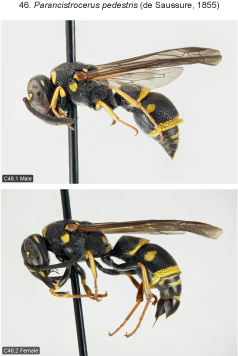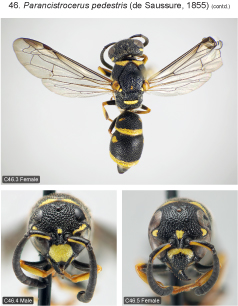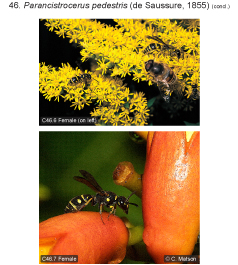
| Home | Table of contents | Keys | Species list | Glossary | Image data | PDF | Cite this article | Feedback | Updates |
Identification Atlas of the Vespidae (Hymenoptera, Aculeata) of the northeastern Nearctic region
CJAI 05, February 19, 2008
doi: 10.3752/cjai.2008.05
Matthias Buck, Stephen A. Marshall, and David K.B. Cheung
Department of Environmental Biology, University of Guelph, Guelph, Ontario, Canada N1G 2W1
Next species | Previous species | Key
46. Parancistrocerus pedestris (de Saussure, 1855)
Figs B7.42, 45, 54, 55; C46.1–7.
 |

|
 |
Species recognition. This species is very similar to P. pensylvanicus from which it can be separated by the colour characters given in the key. Females that lack the scutal spot and discal spots of tergum 1 cannot be separated from P. pensylvanicus. The only reliable structural character that separates both species is the shape of the aedeagus, whose middle portion is abruptly constricted in dorsoventral view in P. pedestris (hardly constricted in P. pensylvanicus). Another species that is strikingly similar is Stenodynerus krombeini (see discussion under that species), which has not yet been recorded from Canada.
Variation. Fore wing length 5.0–6.5 mm (♂♂), 6.0–7.5 mm (♀♀). Thickening of apical margin of tergum 2 variable, its thickness 0.6–1.4x mid ocellar diameter (male) or 0.4–1.0x mid ocellar diameter (female). Body with pale markings always bright yellow. Female clypeus with a yellow crescent-shaped dorsal mark or a pair of dorsal spots, very rarely and only in specimens from eastern U.S. with yellow in apical half of clypeus; male clypeus highly variable, usually with narrow or wide black apical margin, sometimes also with irregular black median blotch(es) on disc, rarely predominantly black and coloured as in female or nearly completely yellow including apical margin between teeth. Interantennal spot restricted to area above interantennal prominence, rarely extending almost to clypeus in male. Male flagellum black beneath or partly obscure yellowish, very rarely yellow as in P. pensylvanicus (1 ♂, ON, Waterloo Reg., Blair; this male has the clypeal margin yellow as in P. pensylvanicus but has a pair of yellow discal spots on tergum 2, and genitalia with the characters of P. pedestris). Transverse pronotal band of variable width and shape, in male sometimes abbreviated laterally, exceptionally interrupted or subinterrupted laterally. Scutum usually with a small to minute posteromedian spot in female (very rarely present in male). Mesopleuron with dorsal spot exceptionally absent in male. Propodeum in female usually with a pair of small to large ventrolateral spots, sometimes also with a pair of small dorsolateral spots, very rarely (in specimens from eastern U.S.) the spots connected and forming two complete vertical bands from dorsum to submarginal carina, rarely propodeum completely black; male propodeum usually entirely black, very rarely with small dorsal and/or ventral spots. Female terga 1–(4)5 and male terga 1–5 or 6 with apical fasciae, the fascia of tergum 3 usually absent, interrupted or reduced to lateral spots, very rarely complete; one aberrant male has all terga beyond tergum 2 completely black. Discal spots of tergum 1 present or absent in female, absent in male, in Canadian specimens not connected to apical fascia; discal spot of tergum 2 present in female, present or absent in male. Sternum 2 with apical fascia, sides of sternum 3 in male more often than in female with apical spots; in male sometimes with interrupted apical fascia.
Distribution. Canada: QC, newly recorded from ON. Eastern U.S. west to MN, KS and NM (Krombein 1979). In Ontario this species is common in appropriate habitats within the Carolinian life zone. Outside this area the species occurs very locally and in much smaller numbers. The reddish form from Florida and Georgia is ssp. bifurcus (Robertson, 1901).
Biology. Nests in borings in wood, sumac and elder and provisions with caterpillars of Gelechiidae. Nest partitions and closing plugs are made from mud (nominate subspecies) or agglutinated sand (ssp. bifurcus) (Krombein 1967, 1979).
Next species | Previous species | Key
| Home | Table of contents | Keys | Species list | Glossary | Image data | PDF | Cite this article | Feedback | Updates |
